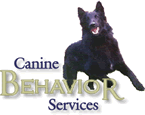Your Weekly Training Tip
March 14, 2010
Often, when our dogs are doing something we don't want them to do, our first reaction to to simply try to stop the behavior - telling the dog "no, don't do that"! Even when this works to stop the behavior, it leaves out an important factor in training: teaching the dog what we would like him to do instead. This "information gap" leaves your dog with countless options, only some of which may be behaviors you prefer to the one you just stopped! When possible, instead of simply attempting to get your dog to stop what he's doing, give your dog concrete direction on what you would like to see him do. This takes a little more thought, but has some real benefits.
Think of some areas that currently present a challenge for your dog, and see if you can think up some good alternative behaviors that you would prefer to see. Some that I regularly use:
With repetition and active appreciation, your dog will begin to adopt the new, alternative behaviors as his own. It takes a little time, but once habit kicks in, and your dogs sees that the new behaviors "pays" better than the old, you are well on your way to a dog who is not only obedient, but well-mannered. Thanks, and until next week, Happy Training! Julie Cantrell BSc, CPDT-KA, CDBC |
Free Dog Training & Behavior Tips If you enjoy our training tips, sign up here to get them in your inbox! With each issue, you'll understand your dog better, and enjoy training more! |
www.k9behaviorservices.com

